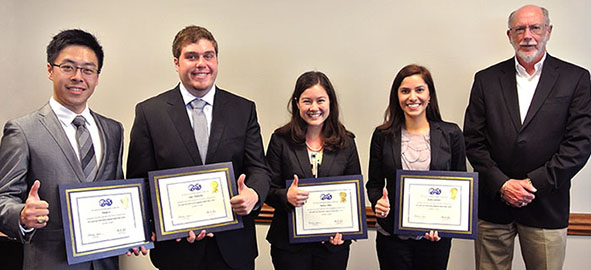Students from the Harold Vance Department of Petroleum Engineering at Texas A&M University recorded three first-place finishes and one second-place finish at the Gulf Coast North America Student Paper Contest.
Karin Gonzalez (Ph.D. division), Hanyu Li (masters division) and Melissa LeRoy (undergraduate division) each placed first, while Isaac Zhukovsky (masters division) placed second.

(in photo, left to right) Li, Zhukovsky, LeRoy, Gonzalez, and Roger Hite, regional director of the Society of Petroleum Engineers Gulf Coast North America Region, pose with certificates.
From determining estimated ultimate recovery with wave propagation models to optimizing water floods in thin bed sandstone, the students covered and demonstrated exceptional knowledge of a wide range of topics.
Gonzalez’s presentation, “Adaptive Grid Refinement Improves Gas Injection Modeling,” introduced work on a new method for creating adaptive mesh refinements and coarsening in compositional reservoir simulation. Her methodology targeted individual cells for refinement based on forecasted compositional fronts and quad tree grid-size analyses. Application of the new approach optimized spatial discretization across the simulation grid, resulting in improved computational performance and better representation of complex fluid phase behavior.
Li’s presentation, “Wave Propagation Models Capture Pressure Diffusion Behavior in Heterogeneous Unconventional Reservoirs,” discussed how determining estimated ultimate recovery (EUR) using information from the boundary-dominated flow regime was not a practical achievement in unconventional (low permeability) resources. The objective of his research project was to determine the EUR of horizontal wells with multistage fractures using only information obtained after wells reached interference between adjacent fractures. It took the first step toward achieving this objective by simulating the boundary condition in heterogeneous reservoirs using the reflection and transmission mechanism of electromagnetic wave propagation to capture the pressure diffusion behavior. He explained how accurate EUR determination can optimize well spacing and limit the number of unnecessary wells drilled, saving millions of dollars in capital investments.
The objectives of LeRoy’s presentation, “Pattern Realignment Optimizes Waterflood in Thin Bed Sandstone,” were to determine the remaining waterflood potential for a deep, thin-bed sandstone reservoir with an existing waterflood and to propose a plan to maximize the economics of future field performance. The solution was to realign existing patterns by converting selected current producers to injectors, which allows for the production of hydrocarbons not initially contacted by the waterflood. The dominant benefit of this approach to increasing recovery is it does not require drilling new wells to increase production. These recommendations are currently being implemented in the West Verden Hoxbar Unit in Caddo County, Oklahoma, where studies show that these conversions are economic at oil prices as low as $29 a barrel.